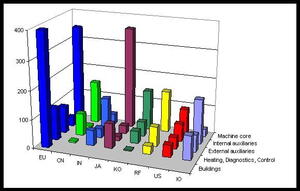Sharing the ITER pie
"PA" is a commonly heard ITER acronym that may take some explanation for the outsider. The two letters stand for Procurement Arrangement—an agreement that is signed between the ITER Organization and the Domestic Agencies authorizing work for the development and manufacturing of the ITER installation.
Seven ITER Members—representing 34 nations—are sharing the responsibility for building the ITER machine and facilities. During the negotiations that preceded the signing of the ITER Agreement, the original sharing of procurement was decided between the Members—about 45.5 percent for Europe, and 9.1 percent each for China, India, Japan, Korea, the Russian Federation and the United States. The lion's share—90 percent—will be delivered by means of in-kind contributions. That means that in the place of cash, the Members will be delivering components and buildings directly to the ITER Organization. But how do you build 9.1 percent of a project, and who's keeping tally?
Procurement Arrangements are a unique ITER invention. Each one of these documents governs the procurement of plant systems, components, or site construction, detailing all the necessary technical specifications and management requirements. The value of each PA is expressed in ITER Units of Account (IUAs). This currency was devised for ITER to measure the value of in-kind contributions consistently over time, effectively neutralizing market fluctuations. Procurement allocations were assigned among the Members on the basis of valuations of components; contributing 9.1 percent of the project, therefore, becomes a matter of adding up the IUA value of the different contributions.
"The in-kind procurement concept in ITER is unique," explains Ina Backbier, who is Senior Project Coordinator in the Project Office. "The ITER Organization and the Domestic Agencies are working together as partners, without a typical client/supplier relationship. The interdependencies between all players in the project make for a very complex technical and organizational work environment."
Sometimes the procurement of one component is shared among multiple Domestic Agencies. In other cases, sub-components from one Domestic Agency may be delivered to others in the supply chain for integration, as in the case of the toroidal field conductors. These conductors are built by six Domestic Agencies and delivered to winding lines established by two Domestic Agencies. "With such complex sharing schemes, a clear management infrastructure and close collaboration are necessary in order to ensure all are on the same page regarding issues like quality control, regulatory requirements, risk management, logistics, acceptance testing and schedule requirements," recounts Ina. "The ITER Organization is maturing at a fast pace; any work conducted under Procurement Arrangements will have to follow the ITER project infrastructure established to ensure full and proper integration at all technical and organizational levels, as well as compliance with the French nuclear regulations."
The finished Procurement Arrangements and their signature represent the culmination of months of intense collaboration. With the signed document in hand, the Domestic Agencies have the authorization to proceed and launch procurements. Depending on the nature and complexity of each system, Domestic Agencies may begin with engineering design work, qualification work and prototyping prior to the start of actual manufacturing. About 140 individual Procurement Arrangements are currently planned to implement the work packages for building ITER; 25 have been signed to-date—representing about 30 percent of the entire ITER value—and the pace is accelerating as major system designs reach finalization.
"The Procurement Arrangements are fundamental instruments of the ITER Project," explains Ina. "They are the main documents by which the ITER Organization authorizes work, and the tool that is the basis of collaboration between the ITER Organization and the Domestic Agencies. They have to be developed with caution and care to ensure they include all requirements for achieving the ITER technical, scientific, schedule, quality, safety and cost targets."



